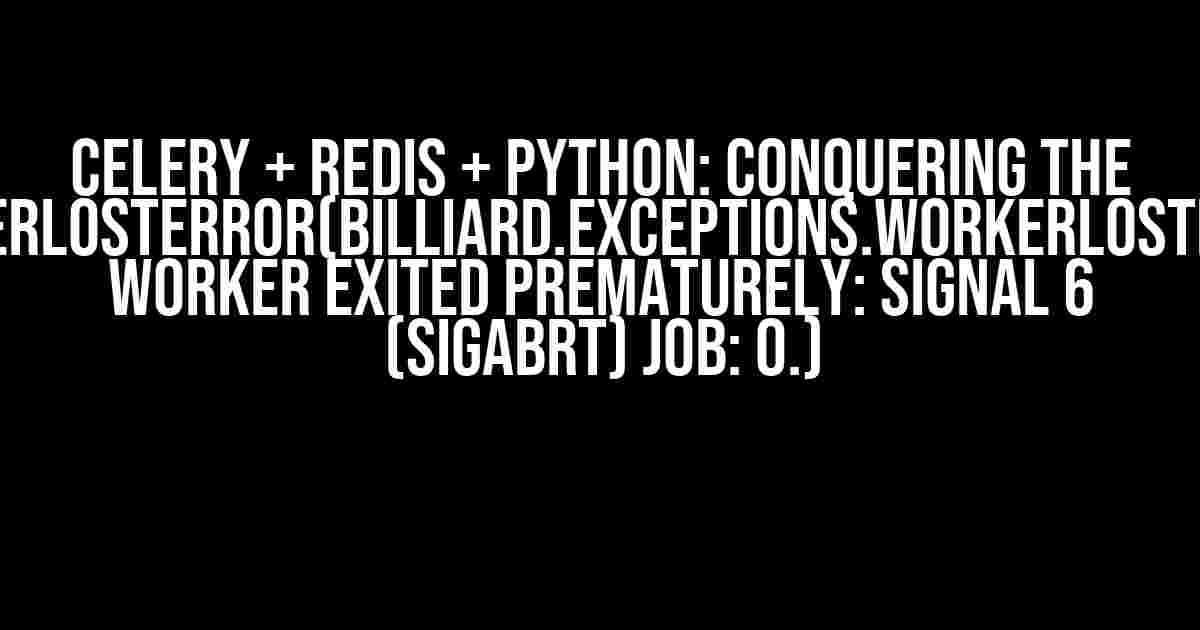Have you ever encountered the dreaded WorkerLostError while working with Celery, Redis, and Python? Do you find yourself scratching your head, wondering what went wrong? Fear not, dear developer, for this article is here to guide you through the treacherous waters of distributed task processing and help you overcome this pesky error.
What is Celery?
Celery is a distributed task queue that allows you to run tasks asynchronously in the background. It’s a perfect solution for tasks that require a significant amount of time, such as image processing, video encoding, or sending emails. Celery uses a broker to manage the queue of tasks, and Redis is a popular choice for this purpose.
The WorkerLostError: What’s Happening?
The WorkerLostError typically occurs when a Celery worker unexpectedly exits while processing a task. This can happen due to various reasons, such as:
- Memory issues: The worker process might run out of memory, causing it to crash.
- Timeouts: If a task takes too long to complete, the worker might timeout and exit.
- SigKill: The worker process might receive a SIGKILL signal, terminating it abruptly.
- Buggy code: A syntax error or an uncaught exception in your code can cause the worker to exit prematurely.
Debugging the Issue
To tackle the WorkerLostError, you need to identify the root cause of the problem. Here are some steps to help you debug the issue:
celery -A app worker --loglevel=debug: Run the Celery worker with debug logging enabled. This will provide you with more detailed information about the error.- Check the Redis logs: Inspect the Redis logs to see if there are any errors or warnings related to the Celery worker.
- Review your code: Carefully review your code to ensure there are no syntax errors or uncaught exceptions that could be causing the worker to exit.
- Increase the worker timeout: If you suspect that the task is taking too long to complete, try increasing the worker timeout using the
-toption.
Redis Configuration: A Possible Culprit?
Redis is a crucial component of the Celery ecosystem, and misconfigured Redis settings can lead to the WorkerLostError. Here are some Redis configuration options to review:
| Option | Description |
|---|---|
| redis-max-memory | The maximum amount of memory Redis can use. If the limit is reached, Redis might terminate the worker. |
| redis-max-clients | The maximum number of connections Redis can handle. If the limit is reached, Redis might refuse new connections, causing the worker to exit. |
| redis- timeout | The timeout for Redis connections. If the timeout is too low, Redis might terminate the worker prematurely. |
Python Code: The Usual Suspects
Sometimes, the issue lies in your Python code. Here are some common mistakes to lookout for:
- Uncaught exceptions: Make sure to catch and handle exceptions properly in your code. Uncaught exceptions can cause the worker to exit.
- Resource-intensive tasks: Tasks that consume excessive resources (e.g., memory, CPU) can cause the worker to crash.
- Long-running tasks: Tasks that take too long to complete might timeout and cause the worker to exit.
Solving the WorkerLostError
Now that you’ve identified the root cause of the issue, it’s time to solve it! Here are some strategies to help you overcome the WorkerLostError:
1. Increase the Worker Timeout
from celery import Celery
app = Celery('app', broker='redis://localhost:6379/0')
@app.task
def my_task():
# Your task code here
pass
2. Use the `soft_time_limit` and `time_limit` Parameters
from celery import Celery
app = Celery('app', broker='redis://localhost:6379/0')
@app.task(soft_time_limit=300, time_limit=360)
def my_task():
# Your task code here
pass
3. Implement Retries and Exponential Backoff
from celery import Celery
app = Celery('app', broker='redis://localhost:6379/0')
@app.task(max_retries=3, default_retry_delay=30)
def my_task():
try:
# Your task code here
pass
except Exception as e:
raise self.retry(exc=e, countdown=30)
4. Monitor Your Workers and Redis Instance
Keep a close eye on your Celery workers and Redis instance to identify potential issues before they cause the WorkerLostError.
Conclusion
The WorkerLostError can be a frustrating experience, but with the right approach, you can overcome it. By following the steps outlined in this article, you’ll be well on your way to identifying and resolving the root cause of the issue. Remember to debug your code, review your Redis configuration, and implement strategies to prevent worker exits. Happy coding!
Here is the FAQ about Celery + Redis + Python: WorkerLostError:
Frequently Asked Question
Got stuck with the WorkerLostError while using Celery, Redis, and Python? Don’t worry, we’ve got you covered! Here are some frequently asked questions to help you troubleshoot the issue.
What is WorkerLostError in Celery?
WorkerLostError is an exception raised by Celery when a worker process exits unexpectedly, typically due to a signal, crash, or terminated process. This can happen when a task encounters an error that’s not handled properly, causing the worker to crash.
What does “signal 6 (SIGABRT)” mean?
Signal 6 (SIGABRT) is a Unix signal that indicates the process has been aborted, usually due to an internal error or inconsistent state. In the context of Celery, it means the worker process received this signal, causing it to exit abruptly.
Why is Celery worker exiting prematurely?
There can be several reasons for a Celery worker to exit prematurely, including MEMORY ERROR, invalid task state, or an unhandled exception in the task code. To troubleshoot, review your task code, check for memory-intensive operations, and ensure proper error handling.
How can I debug WorkerLostError in Celery?
To debug WorkerLostError, start by enabling Celery’s built-in logging and monitoring features. You can also use tools like Flower or Celerymon to monitor your Celery cluster. Review the worker logs to identify the specific task that’s causing the issue and investigate the error further.
What can I do to prevent WorkerLostError in Celery?
To prevent WorkerLostError, ensure your tasks are designed to handle failures and exceptions gracefully. Implement robust error handling, use timeouts, and consider using Celery’s built-in mechanisms like retry and acks_late. Regularly monitor your Celery cluster and update your dependencies to prevent issues.
